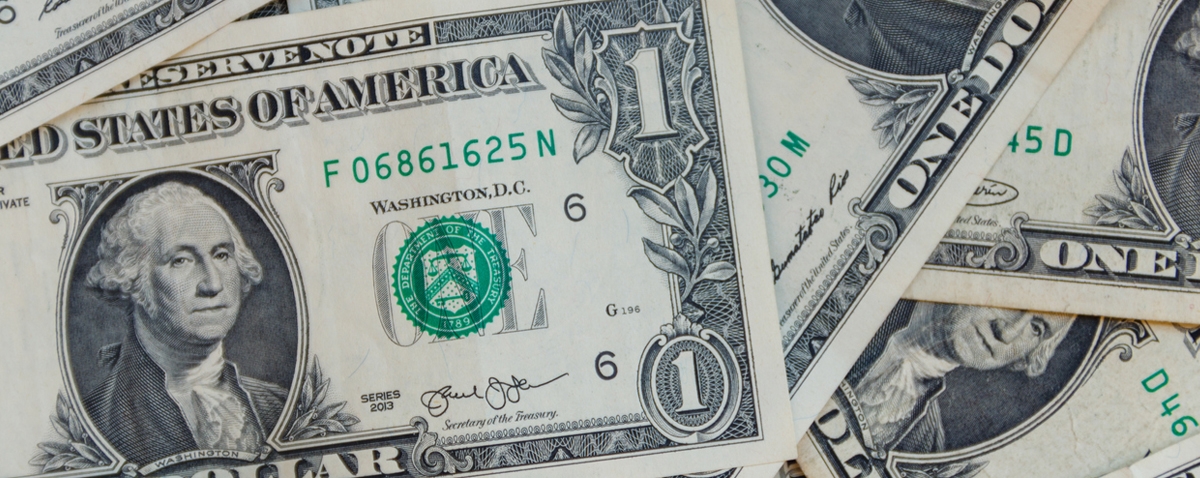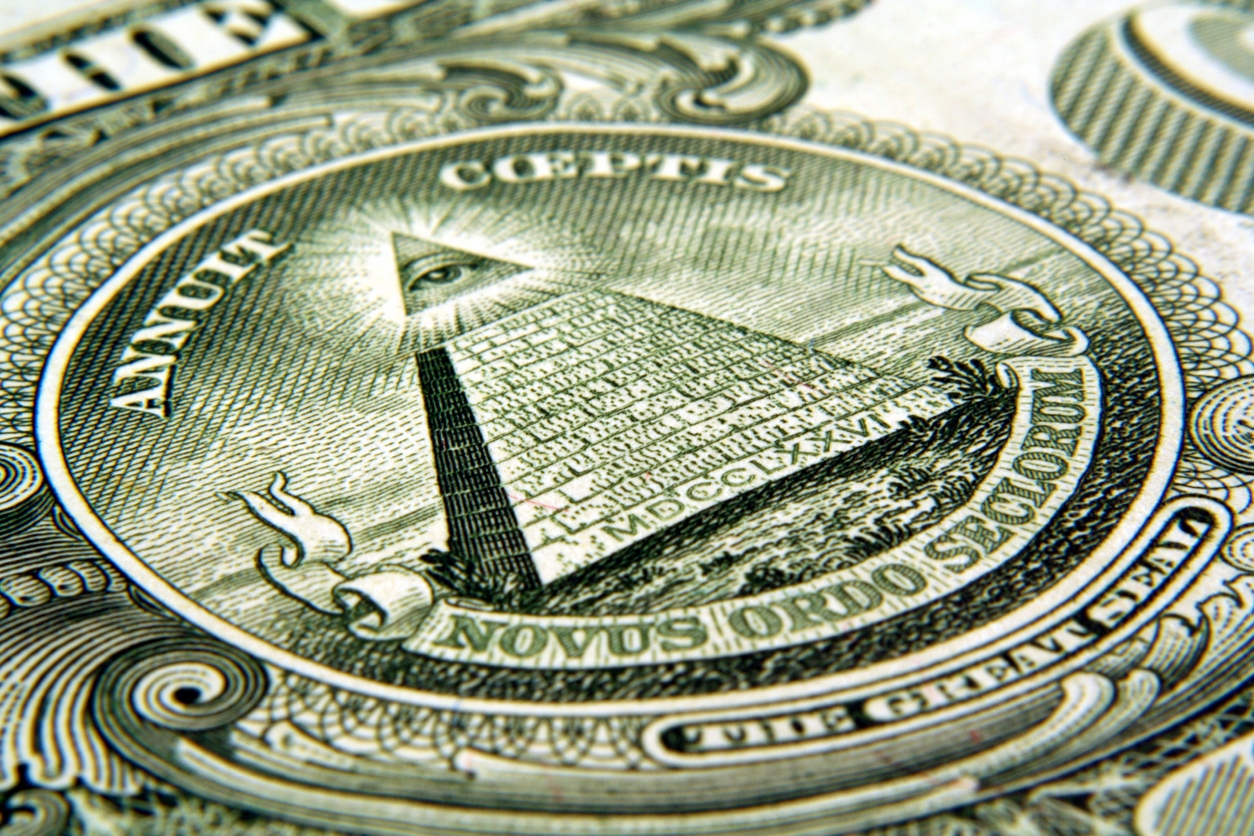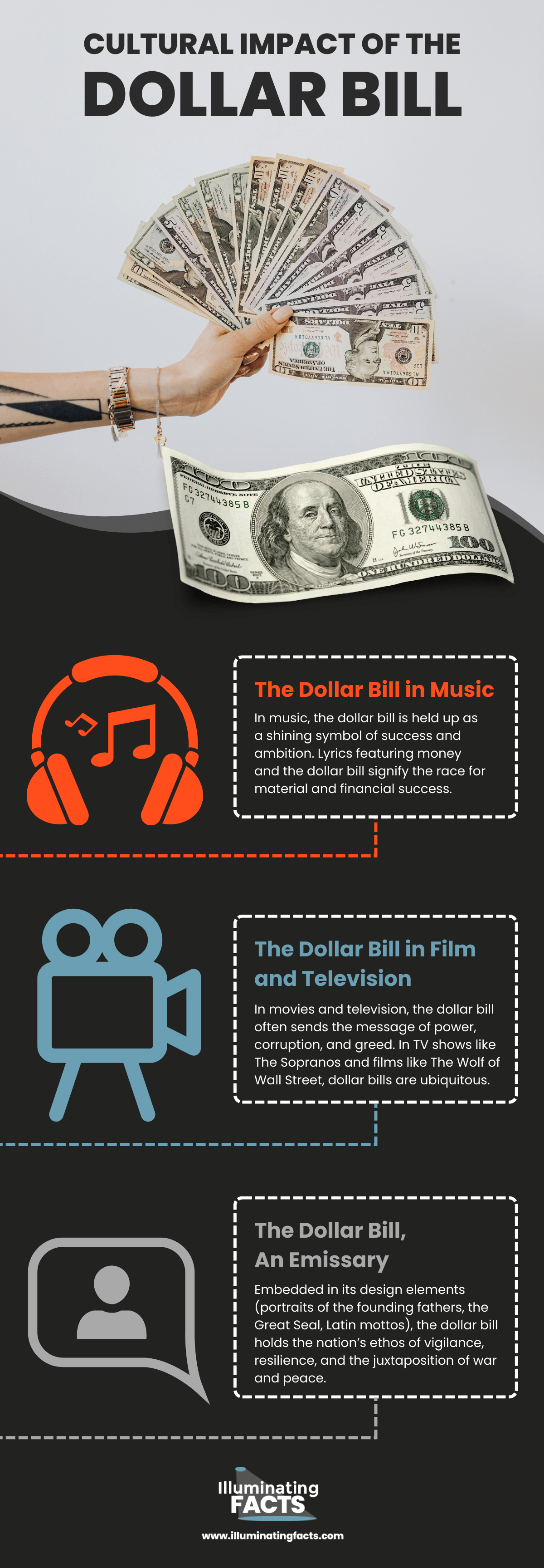cultural impact of the dollar bill, history of the dollar bill, symbolism in the dollar bill, design of the dollar bill, future of the dollar bill, first paper currency, Great Seal of the United States, facts about the 1 dollar bill, facts about the dollar bill, one dollar bill facts, why is there a pyramid on the dollar bill
Beyond the Green: Exploring the Cultural Impact of the Dollar Bill
The dollar bill. It’s unassuming and mundane. But did you know it has traveled a lot before it ended up in your hand? According to the Federal Reserve, a typical dollar bill stays in circulation for 6.6 years [1]. That’s more than six years of changing hands, of visiting tip jars, corner store candy shops, laundromats, garage sales, vending machines, and birthday cards. So while it serves as plain currency, the humble dollar bill is also a silent witness to human life.
Underneath the countless transactions and economic utility, the mundane dollar bill is not so mundane. It can be a token of gratitude or a birthday gift, but it’s also a cultural artifact. That is what we’ll explore. This blog post is not about inflation rates, the mechanics of economics, or fiscal theories. Rather, we’ll study the silent cultural imprints etched onto every bill. It’ll help us piece together the story of America and where it belongs.
We’ll go beyond the green ink and iconic imagery to dig deep into its history and learn the hidden symbolism carved into the bill. It’s a cryptic language that holds a wealth of information about American culture and its values.
The dollar bill has also made an indelible mark on pop culture and on cultures around the world. It mirrors American identity and how that identity is perceived outside America.
We’ll end our discussion with speculation about the future of the dollar bill — how it can survive in the digital age where cashless is quickly becoming the new norm. Together, these facts about the dollar bill tell its whole life story. Let’s dive in and journey beyond the green.
History of the Dollar Bill
The newly formed United States had a pressing need for currency in 1776. The Revolutionary War had just begun. And to finance that war, the Continental Congress introduced the first paper currency that wasn’t backed by gold or silver. It stayed in circulation until 1862 but the currency suffered from counterfeiting. The paper bills were called “Continentals”. [2]
First Dollar Bill
In the middle of the Civil War, the U.S. government needed an unburdened currency. So they printed the first United States notes, including the first dollar bill Called a Legal Tender Note, the first one-dollar bill had a basic design with the numeral “1” and an off-center portrait of Salmon P. Chase (the Treasury Secretary). [3] Later on in 1869, George Washington appeared on the obverse of the dollar bill. And in 1935, the Great Seal of the United States showed up on the reverse.
Evolution of the Dollar Bill Design
The design of the dollar bill evolved over the years: the portraits were centered, the bill size shrunk, and the green ink became the standard. In addition to the design, the government also experimented with other materials. Originally printed on paper, the government switched to a special blend of cotton and linen. Today, they’re printed on a durable polymer blend to discourage counterfeiting.
Symbolism in the Dollar Bill
The current design, featuring George Washington and the Great Seal of the United States, went into circulation in 1963.
The Unfinished Pyramid and the Eagle
The reverse also features an unfinished pyramid with an eye atop. Have you ever wondered why there is a pyramid on the dollar bill? It’s split into 13 steps, representing the original colonies. The eye is supposedly a symbol of divine providence. The icon is meant to symbolize the nation’s ongoing growth and progress.
Next to the pyramid, we find an eagle, grasping arrows, and an olive branch. The arrows embody might and the olive branch signifies peace. It communicates America’s hope for peace and readiness for war. [4]
Latin Phrases
The Latin phrases “Annuit Coeptis” and “Novus Ordo Seclorum” translate to “He has favored our undertakings” and “New Order of the Ages”. [5] They further illustrate the divine providence and the dawn of a new nation.
Interpreting the Symbolism
The symbolism speaks to the changing time and tide. During the time of war, the message of strength and might was etched into it. Later on, new additions of progress and peace took the spotlight.
Besides the obvious emblem of the eagle, the Eye of Providence, and the unfinished pyramid, there are many lesser-known messages hidden in the dollar bill. On the top right of the reverse, you can spot a tiny owl. The owl sits right next to the numeral “1” and it has inspired many conspiracy theories. But most likely, it’s a signature left by the designer of the bill.
If you count the stars engraved on the eagle’s chest, it comes out to 13. The 13 stars represent the 13 original colonies with red, white, and blue. The number appears throughout the bill, including 13 leaves on the olive branch. Upon closer inspection, the eagle also holds a scroll that reads “E pluribus unum”, meaning “Out of many, one”.
The symbolism transforms the dollar bill into a canvas of American history — far more than just a transactional instrument. The canvas illustrates resilience, peace, readiness for war, vigilance, and divine providence. Then there are messages of progress and endurance, embodying the American dream.
Cultural Impact of the Dollar Bill
Beyond the many facts about the 1 dollar bill itself, American popular culture is rife with allegories related to it. It appears in music, movies, literature, and art, often as a symbol of success, corruption, capitalism, and materialism.
The Dollar Bill in Music
In music, the dollar bill is held up as a shining symbol of success and ambition. Lyrics featuring money and the dollar bill signify the race for material and financial success. Sometimes, it even serves as a critique of that quest, reminding the audience of greed, corruption, and poverty.
The Dollar Bill in Film and Television
In movies and television, the dollar bill often sends the message of power, corruption, and greed. In TV shows like The Sopranos and films like The Wolf of Wall Street, dollar bills are ubiquitous. In literature, it represents the unattainability of the American dream. The dollar bill in art is often a social commentary on capitalism, materialism, and power structures.
The Dollar Bill, An Emissary
Embedded in its design elements (portraits of the founding fathers, the Great Seal, Latin mottos), the dollar bill holds the nation’s ethos of vigilance, resilience, and the juxtaposition of war and peace. Beyond the rich history, intricate symbolism, and pop culture references, the dollar bill mirrors American identity. Outside America, the dollar bill is a symbol of American power and influence. The dollar bill is an international currency. Owing to its stability, many countries prefer the American dollar over local currency. The markets in these countries commonly list their prices in US dollars.
The dollar bill carries within it the image of America that anyone, anywhere would recognize. Dominant as it is, the perception of the American dollar remains mixed. It is just as often viewed as a symbol of economic disparity and inequality.
The Future of the Dollar Bill
The subject of the future of the dollar is of certain intrigue too. Forces and factors in the modern world threaten not just its current shape, but even its survival.
Digital Currency
Digital payment systems and digital currencies like Cryptocurrency are changing the way we conduct our business. [6] Even the Federal Reserve is exploring a way to digitize the dollar. [7]
The trends show that we’re becoming more and more cashless. At the same time, inflation is disrupting the relevance and power of the dollar. The dollar bill has survived many inflation storms before. But it might not stand up to persistent inflation.
Environmental Considerations
Printing the dollar bill exacts an environmental and economic cost. People have argued that the dollar bill has a short lifespan and the environmental cost of printing makes it unfriendly. They propose the dollar bill be replaced with a coin that has a considerably longer lifespan. A coin will also be more economically sound and environment-friendly.
A Piece of Americana Might Be Lost
But despite the coalition of these factors, we must consider that the dollar bill is more than just currency. It’s symbolic. Its rich history makes it a cultural artifact, a piece of Americana. Even the tactile experience — the feel of crisp dollar bills, the rustles of counting them, and their smell — influences how we perceive wealth and value.
If the dollar bill disappears, the tactility and the cultural narrative will be lost to 1s and 0s. It’ll shift how we perceive money and value in the long term. And of course, digital money cannot be imprinted with the physical cultural imprints we find on the dollar bill.
Conclusion
On our journey beyond the green, we investigated the birth of the American dollar bill. We explored how it evolved, how time and tide shaped its design, and how American ideals of prosperity, resilience, hope for peace, and readiness for war, are etched into the fabric of the dollar bill. We also learned some interesting one-dollar bill facts along the way.
We also saw how, during its long lifetime, the dollar bill made its way into popular American culture. Music, film, television, and art are rife with themes of success, corruption, greed, and power, conveyed using the dollar bill. Unassuming as it is, the dollar bill also serves as an emissary for America. When it travels the globe, it narrates the tales of American identity, shaping how the world perceives America.
Digital currencies are gaining more ground every day. And the need for sustainable growth in an increasingly cashless society threatens the bill’s fate. The portrait of America we see reflected in the dollar bill might not persist forever. So, when you take a dollar bill out to pay for your coffee order, pause for a moment to feel its texture and study the hidden symbols etched into it. The green bill has many stories to tell, some perhaps about your cultural identity.
References
[1]. How long is the lifespan of U.S. paper money? (n.d.). Board of Governors of the Federal Reserve System. https://www.federalreserve.gov/faqs/how-long-is-the-life-span-of-us-paper-money.htm
[2].History of U.S. currency | U.S. currency education program. (n.d.). The U.S. Currency Education Program. https://www.uscurrency.gov/history
[3] $1 Note | Engraving & Printing. (n.d.). Bureau of Engraving and Printing. Retrieved June 28, 2023, from https://www.bep.gov/currency/circulating-currency/1-note
[4]. Dollar bill trivia. (n.d.). Kids Environment Kids Health – National Institute of Environmental Health Sciences. https://kids.niehs.nih.gov/games/riddles/jokes/dollar-bill-trivia
[5]. Dollar Bill Trivia. (n.d.). Kids Environment Kids Health. Retrieved June 28, 2023, from https://kids.niehs.nih.gov/games/riddles/jokes/dollar-bill-trivia
[6]. Rodeck, D. (2022, October 19). Digital currency: The future of your money. Forbes Advisor. https://www.forbes.com/advisor/investing/cryptocurrency/digital-currency/
[7]. Why the U.S. is eyeing a digital dollar. (2022, December 28). PBS NewsHour. https://www.pbs.org/newshour/politics/what-is-a-digital-dollar-and-what-does-it-mean-for-privacy-and-banking






